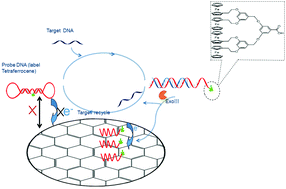Multi-signal amplification electrochemical DNA biosensor based on exonuclease III and tetraferrocene†
Abstract
Homogeneous electrochemical DNA biosensors’ unique qualities have been of great interest to researchers, mainly due to their high recognition efficiency in solutions. However, the processes of introducing additional markers and extra operations to obtain a signal are tedious and time consuming, which limits their overall potential applications. Herein, a novel tetraferrocene was synthesized and used as a homogeneous electrochemical DNA biosensor probe label. It contains four ferrocene units, which provide greater signaling potential compared to monoferrocene. Furthermore, the target DNA triggers the digestion of the double hairpin DNA probe with the aid of exonuclease III, promoting short single stranded DNA probe formation. With the combination of the incorporated tetraferrocene labeled short DNA probe strands and graphene's ability to adsorb single stranded DNA, the hybridization process can produce an electrode signal provided by tetraferrocene. A low detection limit of 8.2 fM toward target DNA with excellent selectivity was achieved. The proposed sensing system avoids tedious and time-consuming steps of DNA modification, making the experimental processes simpler and convenient. The advantages of high sensitivity, selectivity and simple operation make this strategy applicable to DNA detection.



 Please wait while we load your content...
Please wait while we load your content...